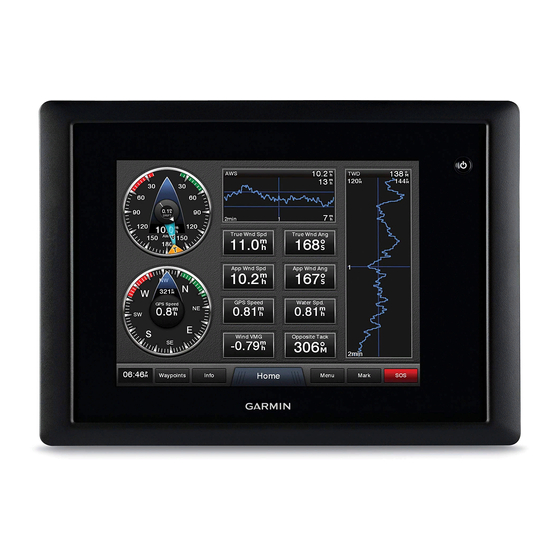Garmin GPSMAP 8215 MFD Instrukcja obsługi - Strona 23
Przeglądaj online lub pobierz pdf Instrukcja obsługi dla Morski system GPS Garmin GPSMAP 8215 MFD. Garmin GPSMAP 8215 MFD 36 stron. Installation instructions
Również dla Garmin GPSMAP 8215 MFD: Skrócona instrukcja obsługi (4 strony), Instrukcja obsługi (15 strony)

uses that channel for subsequent calls until you call using
another channel.
1
Select Info > DSC List.
2
Select a vessel or a station to call.
3
Select Review > Call with Radio > Channel.
4
Select an available channel.
Making an Individual Routine Call
NOTE: When initiating a call from the chartplotter, if the radio
does not have an MMSI number programmed, the radio will not
receive call information.
1
Select Info > DSC List.
2
Select a vessel or a station to call.
3
Select Review > Call with Radio.
4
If necessary, select Channel, and select a new channel.
5
Select Send.
The chartplotter sends information about the call to the radio.
6
On your Garmin VHF radio, select Call.
Making an Individual Routine Call to an AIS Target
1
From a chart or 3D chart view, select an AIS target.
2
Select AIS Vessel > Call with Radio.
3
If necessary, select Channel, and select a new channel.
4
Select Send.
The chartplotter sends information about the call to the radio.
5
On your Garmin VHF radio, select Call.
Gauges and Graphs
The gauges and graphs provide various information about the
engine and environment. To view the information, a compatible
transducer or sensor must be connected to the network.
Viewing Engine and Fuel Gauges
Before you can view engine and fuel gauges, you must be
connected to a NMEA 2000 network capable of sensing engine
and fuel data. See the installation instructions for details.
Select Info > Gauges.
Customizing Engine Gauge and Fuel Gauge Limits
You can configure the upper and lower limits and the range of
desired standard operation of a gauge. When a value exceeds
the range of standard operation, the gauge becomes red.
NOTE: Not all options are available for all gauges.
1
From the engine gauges screen, select Menu > Gauge
Setup > Set Gauge Limits.
2
Select a gauge.
3
Select Gauge Limits > Mode.
4
Select an option:
• To set the minimum value of the standard operating
range, select Rated Min..
• To set the maximum value of the standard operating
range, select Rated Max..
• To set the lower limit of the gauge lower than the rated
minimum, select Scale Min..
• To set the upper limit of the gauge higher than the rated
maximum, select Scale Max..
5
Select the limit value.
6
Repeat steps 4 and 5 to set additional gauge limits.
Enabling Status Alarms for Engine Gauges
You can enable the chartplotter to display engine status alarms.
Gauges and Graphs
From the engine gauges screen, select Menu > Gauge
Setup > Status Alarms > On.
When an engine alarms is triggered, a gauge status alarm
message appears and the gauge may become red depending
on the type of alarm.
Enabling Some Engine Gauge Status Alarms
1
From the engine gauges screen, select Menu > Gauge
Setup > Status Alarms > Custom.
2
Select one or more engine gauge alarms to turn on or off.
Selecting the Number of Engines Shown in Gauges
You can show information for up to four engines.
1
From the engine gauges screen, select Menu > Gauge
Setup > Engine Selection > Num. Engines.
2
Select an option:
• Select the number of engines.
• Select Auto Configure to automatically detect the
number of engines.
Customizing the Engines Shown in Gauges
Before you can customize how the engines are shown in the
gauges, you must manually select the number of engines
(page
17).
1
From the engine gauges screen, select Menu > Gauge
Setup > Engine Selection > Edit Engines.
2
Select First Engine.
3
Select the engine to display in the first gauge.
4
Repeat for the remaining engine bars.
Setting the Fuel Capacity of the Vessel
1
Select Settings > My Vessel > Fuel Capacity.
2
Enter the combined total capacity of the fuel tanks.
Synchronizing the Fuel Data with the Actual Vessel
Fuel
You can synchronize the fuel levels in the chartplotter with the
actual fuel in the vessel when you add fuel to your vessel.
1
Select Info > Gauges > Engine > Menu.
2
Select an option:
• After you have filled up all the fuel tanks on the vessel,
select Fill Up All Tanks. The fuel level is reset to
maximum capacity.
• After you have added less than a full tank of fuel, select
Add Fuel to Boat, and enter the amount added.
• To specify the total fuel in the vessel tanks, select Set
Total Fuel Onboard, and enter the total amount of fuel in
the tanks.
Setting the Fuel Alarm
Before you can set a fuel level alarm, a compatible fuel flow
sensor must be connected to the NMEA 2000 network.
You can set an alarm to sound when the total amount of
remaining onboard fuel reaches the level you specify.
1
Select Settings > Alarms > Fuel > Fuel Alarm > On.
2
Enter the remaining amount of fuel that triggers the alarm.
Viewing Trip Gauges
Trip gauges show information for odometer, speed, time, and
fuel for your present trip.
Select Info > Trip & Graphs > Trip Data.
Resetting Trip Gauges
1
Select Info > Trip Data.
17
